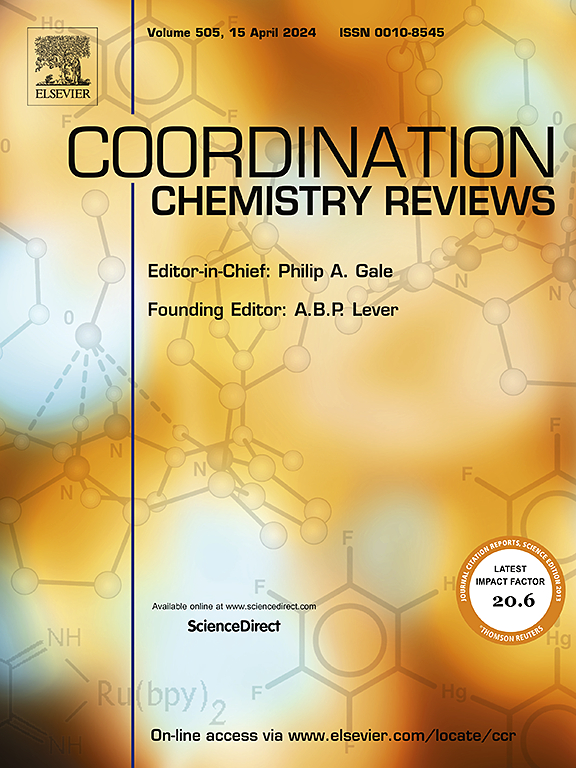Recent advances in nickel Catalysis for thermoplastic polyethylene elastomers: Synthesis strategies, properties, and future perspectives
IF 20.3
1区 化学
Q1 CHEMISTRY, INORGANIC & NUCLEAR
引用次数: 0
Abstract
Polyolefins, particularly polyethylene (PE), rank among the most significantly applied synthetic polymers due to their exceptional chemical, thermal, and physical properties, which underpin their broad application spectrum. The characteristics of these polymers, such as flexibility, elasticity, and mechanical strength, are largely dictated by the polymerization process, catalyst selection, and polymer molecular architecture. Thermoplastic polyolefin elastomers (POEs) represent a notable subclass, prized for their ease of processing—allowing shaping, molding, and recycling—combined with their characteristic elastic properties. These materials are typically synthesized as branched or block copolymers of ethylene and α-olefins using early transition metal catalysts. The advent of late transition metal catalysts, particularly those based on nickel, has paved the way for a more direct approach to produce thermoplastic elastomers. These catalysts, with their distinctive chain-walking capability, obviate the need for comonomers, enabling the synthesis of branched polyethylene elastomers (PEEs) with the potential to replace traditional POEs. This review delves into the advancements in PEE synthesis via nickel catalysis, focusing on the design principles behind nickel catalysts that facilitate controlled branching. It critically evaluates the interplay between catalyst structure, reaction conditions, and polymer properties, emphasizing how these variables can be optimized to enhance elasticity, strength, and processability of PEE. Additionally, the review compares PEEs with conventional POEs, highlighting the superior balance of elasticity and thermoplasticity that makes PEEs advantageous for specific applications. Finally, the article addresses current challenges in fine-tuning the catalyst design, branching architectures and offers perspectives on future research directions in the development of catalyst design for high-performance PEEs.

镍催化热塑性聚乙烯弹性体的最新进展:合成策略、性能和未来展望
聚烯烃,特别是聚乙烯(PE),由于其特殊的化学、热学和物理性能,成为应用最广泛的合成聚合物之一,这为其广泛的应用奠定了基础。这些聚合物的特性,如柔韧性、弹性和机械强度,很大程度上取决于聚合过程、催化剂选择和聚合物分子结构。热塑性聚烯烃弹性体(poe)代表了一个显著的亚类,因其易于加工-允许成型,成型和回收-结合其特有的弹性性能而受到重视。这些材料通常用早期过渡金属催化剂合成为乙烯和α-烯烃的支链共聚物或嵌段共聚物。晚期过渡金属催化剂的出现,特别是那些基于镍的催化剂,为更直接地生产热塑性弹性体铺平了道路。这些催化剂具有独特的链行走能力,不需要单体,可以合成支链聚乙烯弹性体(pee),有可能取代传统的poe。这篇综述深入研究了通过镍催化合成PEE的进展,重点介绍了镍催化剂背后的设计原则,以促进控制分支。它批判性地评估了催化剂结构、反应条件和聚合物性能之间的相互作用,强调如何优化这些变量以提高PEE的弹性、强度和可加工性。此外,该综述还将pee与传统poe进行了比较,强调了pee在弹性和热塑性方面的优异平衡,这使得pee在特定应用中具有优势。最后,本文阐述了目前在微调催化剂设计、分支结构方面所面临的挑战,并对高性能聚丙烯腈催化剂设计的未来研究方向提出了展望。
本文章由计算机程序翻译,如有差异,请以英文原文为准。
求助全文
约1分钟内获得全文
求助全文
来源期刊

Coordination Chemistry Reviews
化学-无机化学与核化学
CiteScore
34.30
自引率
5.30%
发文量
457
审稿时长
54 days
期刊介绍:
Coordination Chemistry Reviews offers rapid publication of review articles on current and significant topics in coordination chemistry, encompassing organometallic, supramolecular, theoretical, and bioinorganic chemistry. It also covers catalysis, materials chemistry, and metal-organic frameworks from a coordination chemistry perspective. Reviews summarize recent developments or discuss specific techniques, welcoming contributions from both established and emerging researchers.
The journal releases special issues on timely subjects, including those featuring contributions from specific regions or conferences. Occasional full-length book articles are also featured. Additionally, special volumes cover annual reviews of main group chemistry, transition metal group chemistry, and organometallic chemistry. These comprehensive reviews are vital resources for those engaged in coordination chemistry, further establishing Coordination Chemistry Reviews as a hub for insightful surveys in inorganic and physical inorganic chemistry.
 求助内容:
求助内容: 应助结果提醒方式:
应助结果提醒方式:


